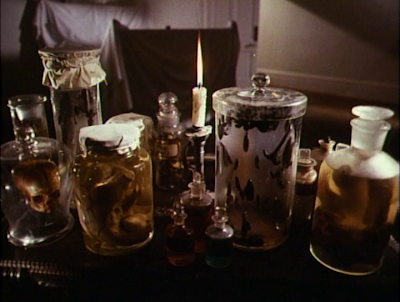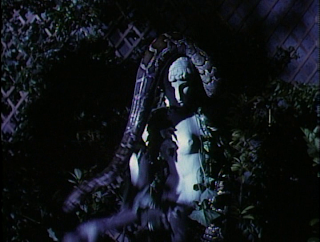Ken Russell: Gothic/Lair of the White Worm
As this retrospective comes to an end, I thought it appropriate to review these two low-budget horror efforts by Ken Russell together (I understand that this may seem like an arbitrary stopping-off point, but this is the conclusion I feel the retrospective has led itself to). Both Gothic and Lair of the White Worm are two very different types of horror films – the former is cerebral and fantastical like the best of Russell’s work while the latter is lazy b-level filmmaking that is not reminiscent of Russell at all – that Russell ended up making because he needed money. Russell, coming fresh off an unsuccessful two-film run in America (read about those here and here), came back from his American sojourn looking to get back to small, non-studio films. However, what he really was looking to do was bankroll some more films with low budget horror flicks that he thought he could get to make him some money. The result wasn’t anything that catapulted Russell back into the forefront of experimental cinema (although he did experiment a lot with home video stuff), and, sadly, kind of ended his career more as “that guy from Big Brother” than one of the most amazing auteurs of the 70s.
Gothic is a return to form for Russell as his outré tendencies lend themselves better to the anything-goes world of horror. Like all of all Russell’s films, Gothic is obsessed with the creation of art and the detours – often aided by hallucinogens – it takes into the realm of the psycho-sexual. Uncle Ken places us inside the minds of two very famous literary figures as they are challenged to cook up a scary story. Gabriel Byrne is Lord Byron, the host of the party; Julian Sands is Percy Bysshe Shelley; and Natasha Richardson, daughter of Vanessa Redgrave of Russell’s The Devil's, plays Mary Shelley. Certain images get us to think about how Shelley was able to create the story of Dr. Frankenstein and his obsession with making the inanimate animate. There is some of the roughest imagery that Russell has used in any film with the visualization of Shelley’s birth that resulted in the infant dying, said infant in a crib with its own skeleton, and again said baby dead and floating in the water – the film’s final, haunting image.
Not unlike he did with his versions of Mahler and Liszt, Russell treats Shelly and Byron like rock stars with groupies and all. Byrne is the standout here as Byron. He plays it with just the right amount of madness, glee, and camp that he turns his estate – and the evil party he throws with his literary friends – into a wild haunted house filtered through the lens of Russell. This genre and setting, on paper, lends itself well to Russell’s tendencies, and he delivers with a few “wow” moments (and he’s created a lot of these). Some of these “wow” moments include: Timothy Spall (who runs around the entire film as a drugged up lunatic…it’s a great performance and one of the inspirations for Shelley’s novel) as mad doctor looking at a woman’s breasts and as the camera pans down, the nipples turn into eyes; Spall trying to make love to some kind of an automaton thing (I think) that is wearing a mask that looks like it belongs in the Eyes Wide Shut orgy scene; Henry Fuseli’s “The Nightmare,” the famous oil painting, is referenced (and got the poster for the movie banned in the UK) and provides the inspiration for one of the film’s best illusory moments involving Mary Shelley; and the aforementioned scene with infant in its crib with its own skeleton sleeping next to it.
Gothic is everything the title promises to be: moody, overwrought, and melodramatic. In other words, it’s every Ken Russell movie ever made. The characters impair their senses so that they can hallucinate about bizarre goings-on and confront their deepest fears in hopes of finding material scary enough to impress their colleagues. This, of course, lends itself to the kind of loose narrative loves to hang his bizarre images on. A lot of those images are so stimulating because of the way Russell lights the estate at night: with the eerie moonlight and raging lightning storm creating all kinds of shadows from the railings as coils and spirals abound. It really reminds me of some of Argento’s best gothic horror work Suspiria and Inferno, and it’s really – considering the budget here – some of my favorite imagery in all of Russell’s oeuvre.
Gothic is just the right length at a little over 80 minutes as the film’s premise grows a bit tiresome by the end of the film where it starts to obtain a frustrating pattern of people looking deranged, some heavy breathing followed by idle threats from one character to another, the characters running around the house a lot, creepy hallucinations that seem recycled or not as interesting as the ones we were introduced to in the first half of the film, and then repeat this scenario for 30 minutes. It doesn’t ruin the first half of the film by any means, but it does keep it from becoming one of Russell’s masterpieces. Even Russell himself seemed to understand his limitations and admitted that, as a pop-music director, his style (“punchy” as he calls it) with its short, quickly cut sequences wears on the viewer after a while. So, one of the film’s strength is its pacing and runtime, especially since Russell fans have pretty much seen every trick he has in his bag and understand his modus operandi (rock soundtrack accompanying batshit crazy excess filling up every frame of the film).
______________________________________________________________
A pretty straight forward horror movie coming off of Gothic that lacks the excess and energy one is accustom to when sitting down to watch a film by Russell. Now, maybe it’s just because I watched it on the heels of Gothic, but Lair of the White Worm is a lifeless movie. The film is actually quite banal considering who we’re dealing with here and the genre he’s working in, but here it is: the first Russell movie since The Music Lovers that left me in a state of ambivalence. At least Crimes of Passion had a dildo-donning, murderous street preacher.
I was mildly entertained for about half of Lair of the White Worm, but there just wasn’t enough going on to hold my interest. It’s reminiscent of one of those B-level AIP horror flicks; one of those fun, goofy rides that one comes to expect from this style of horror picture. However, the majority of those AIP pictures were made with a lot of energy mixed with earnestness (and some carnival/road side attraction-type marketing to get people in the theater), and there’s nothing consistently approaching that kind of tone in Lair of the White Worm. The only time there’s even a hint of life and energy in the film is when people are bit by the vamp…er snake, and they hallucinate. Even those scenes seem like recycled bits of those really interesting, superimposed, green screen hallucinations Russell used to better effect in Altered States. Here, it’s just mildly interesting but mostly bad because he’s trying to do it with a quarter of the budget.
Amanda Donohue plays the Snake Woman – not a vampire – and she is collecting bodies to feed off of so that she can make one final sacrifice and opens some kind of portal to hell where a giant worm puppet emerges to eat the virgin sacrifice. Or something like that. To tell you the truth, and I always try to at least have a vague understanding of the plot, I didn’t know what the hell was going on here. I was too bored to care to rewind and too uninterested to infer. So I just watched the film figuring I could at least get something out of it visually because it’s a Russell film. No such luck. I know Hugh Grant shows up somewhere as a – gasp – smug, upper class bloke.
There are a few so-bad-it’s-good type moments in the film, mostly involving the matter-of-fact dialogue. When the Snake Woman picks up a young man walking alongside the road, she proceeds to take him to her house and give him a bath. He’s younger and is a bit shy about being naked in front of her. She tells him to stand up so that she can scrub him down, and she eases his worries by saying, “Don’t worry, it’s not like I’m going to bite you.” It’s all so predictable, but that can often be half the fun of a movie like this, and the cheesy lines are only part of its charms that give the film its B-level, Roger Corman-esque feel (there’s another on-the-nose line that is refreshingly awful when she says, “I change my cars like a snake sheds its skin.”). There’s nothing inherently bad about the film, it just feels like lazy, lesser Russell. Aside from one moment that has the sacrilegious energy reminiscent of The Devils, Lair of the White Worm could have been directed by pretty much any old low-rent horror director.
What’s most sad about watching these films with the benefit of hindsight is the knowledge that even though these two quick, low-budget cash grabs were meant to get Russell back on track, they never did. His 90s output was just as sad (Whore is the only notable film), and he basically just became a reality television star in the 2000s becoming more known for his stint on the television show “Big Brother” than for anything he released (which were relegated to non-theatrical releases). Even though I think Gothic holds up as one of Russell’s more interesting films, it never quite feels quintessential Russell a la Tommy, The Devils, Savage Messiah or Mahler as the theme of creating and the crazy imagery that accompanies it falls by the wayside by the final half-hour where all the characters do is run around the house like an episode of “Scooby-Doo.” Lair of the White Worm on the other hand doesn’t seem to have a semblance of the inspired-Russell in it. No signs of the auteur that gave us some of the most insane imagery in the history of cinema. Even the few shock scenes in Lair of the White Worm just feel like tired attempts at recreating something controversial he did in the 70s. Perhaps there’s a whole subversive nature – a subtext that I just don’t get – with the film, but it left me numb and bored and sad that such a great, interesting, often infuriating but always magnificently iconoclastic, filmmaker could produce something so…normal.
Extra Stills:





























































I saw Gothic (or most of it) once, back in (I think) 1996 when I was a teenager. I don't remember much about it other than the fact it made little sense, although the life-size mechanical stripper doll and the ghost story in which a woman gets raped by a walking suit of armour stuck in the memory. I wouldn't mind seeing it again, maybe I could make more sense of it these days.
ReplyDelete